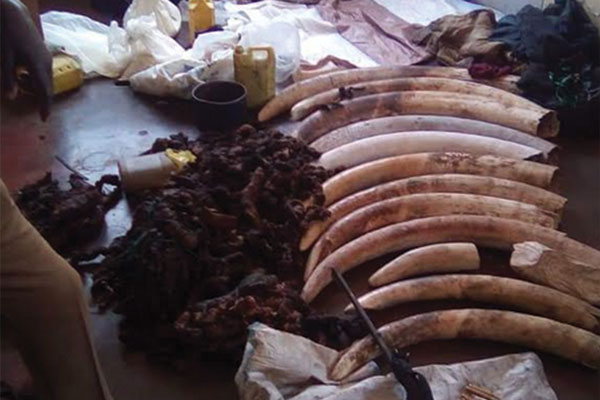
HWANGE National Park rangers recently recovered 13 elephant tusks, a rifle and cellphones after a shoot-out with six suspected Zambian poachers as poaching activities surge.
BY NOKUTHABA DLAMINI

Bhejane Trust conservationist, Trevor Lane said two Zimbabwe Parks and Wildlife Management Authority (ZimParks) rangers tracked a group of six poachers and caught up with them at Inyantue area in the dead of the night.
“On Saturday, two rangers based in Sinamatella on a patrol in the Inyantue area found tracks of a group of six poachers. After tracking them for about six hours, they encountered the group resting. They opened fire, but unfortunately, the whole group escaped.”
“However, all their kit and ivory was recovered — this included 13 elephant tusks weighing 172kg in total. It looks like three of these tusks were old and thus pick-ups. Therefore, the group had shot six elephants on this trip. There was also a .375 rifle with ammunition, a Zambian cellphone, a Zambian ID document, various personal kits, dried elephant and buffalo meat and assorted medicines,” Lane said.
Zimparks spokesperson Tinashe Farawo said: “That incident happened on Saturday. I don’t have written details now, but I can confirm that. Once I get written documents from Hwange, I will share.”
Lane said in one survey flight undertaken in Botswana recently, they counted 48 elephant carcasses with the tusks hacked off in Chobe near Hwange and Matetsi in Zimbabwe. In June, ZimParks rangers gunned down a poacher heading towards the Botswana border while five others fled.
They were in possession of 15 elephant tusks, rifles, ammunition and camping equipment.
- Chamisa under fire over US$120K donation
- Mavhunga puts DeMbare into Chibuku quarterfinals
- Pension funds bet on Cabora Bassa oilfields
- Councils defy govt fire tender directive
Keep Reading
Lane said most of the poachers killed in the area were from Botswana, crossing through Zimbabwe into Zambia.
“Finally, reality has dawned on Botswana, that they have a massive poaching problem — this flight represents the tip of the iceberg.
“This was an open invitation to the Zambian poaching gangs, who had it tough in Zimbabwe as many of their key members had been killed in contacts with the ZimParks rangers. Now they had areas where they could operate in relative safety,” Lane said in a statement.
“The poaching gangs thus generally by-passed Zimbabwe, crossing near Kazungula and linking up with Namibians. They then traversed the Chobe into the back areas, where they could then shoot elephants. Some of the gangs would take a short cut from the tedious trip all the way around the tip of Zimbabwe, and a couple of gangs paid the price, encountering Zimbabwean rangers with their ring leaders killed and all their spoils recovered.
“The Zambian poachers only shoot bulls as they do not want to be burdened with lots of small tusks.”
Lane said it was worrying that Zambians authorities had not joined the fight against poaching.
“Of note is that these Zambians are crossing the lake (Zambezi River) and traversing all the way to Hwange to poach. The Sebungwe area is now of no interest to them as they have wiped out all the big ivory. As per normal, we can expect no assistance or follow-ups from the Zambians.”











